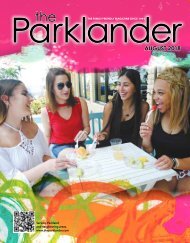September 2018
Create successful ePaper yourself
Turn your PDF publications into a flip-book with our unique Google optimized e-Paper software.
Photos by Sheila Johnson of Treehouse Studios<br />
Visitor at the Calusa sand-filled, tree-covered burial mound.<br />
Replica of Calusa saw made of shark teeth.<br />
Calusa ceremonial mask replicas.<br />
the Calusa didn’t farm. They discarded shells in piles that grew higher than 30<br />
feet and longer than football fields, and built communal shelters of wood and<br />
palm-thatch on the mounds where the elevation enabled them to see enemies<br />
approaching and protect them from lowland flooding.<br />
The Calusa used animal bones and shells as tools to hollow out wood for<br />
canoes, make paddles, bowls, weapons, and create elaborate carvings in wood<br />
and shells, some of which are preserved today.<br />
Somehow they dug a network of canals by hand, 6 feet deep and 30 feet wide,<br />
canals no longer visible. The research center still conducts archeological “digs”<br />
at the site in search of further artifacts to enhance our knowledge. A walking<br />
trail through fields and wooded area passes the mounds and a sand-filled burial<br />
mound. The trail is dotted with informational signs about Calusa history, and an<br />
informational visitors center and gift shop sells an array of related items.<br />
The complete story of the long-lost Calusa Native Americans is told at the<br />
Florida Museum of History in Gainesville, where the museum opened in 2002. P<br />
the PARKLANDER 21





